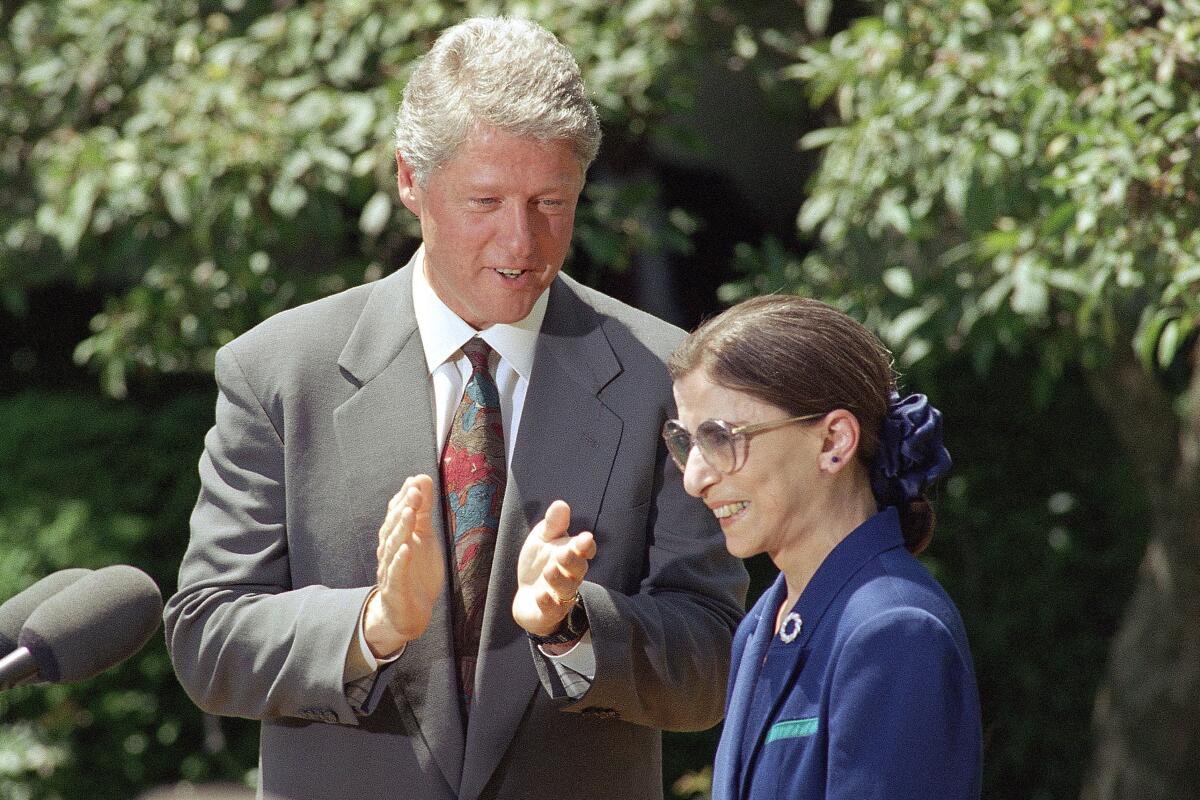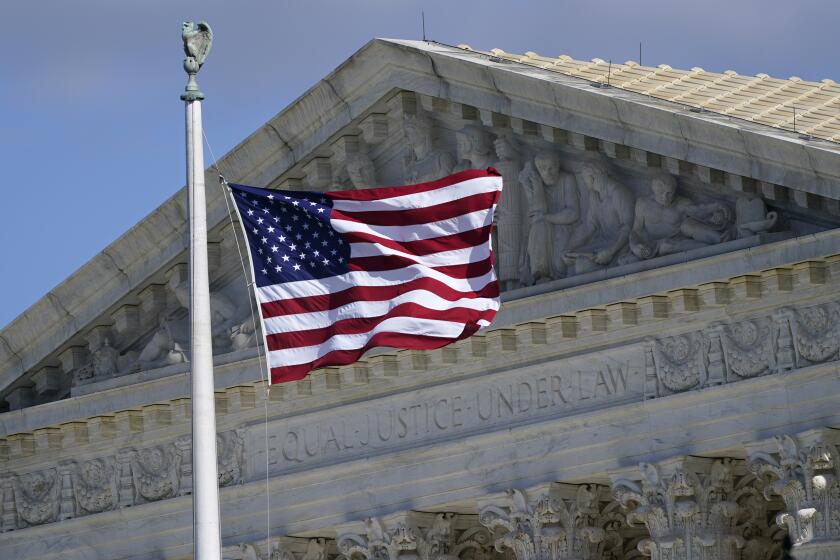Ginsburg’s death sets up what could be the sharpest Supreme Court shift in three decades

- Share via
WASHINGTON — When Ruth Bader Ginsburg joined the Supreme Court in 1993, she was its lone Democratic appointee, the first in 26 years. Her eight colleagues were named by the four Republican presidents from Richard Nixon to George H.W. Bush.
They were not all conservatives, however. Ginsburg voted regularly with John Paul Stevens and David H. Souter, nominees of Gerald R. Ford and Bush, respectively. And in her later years, she aligned with President Obama’s two picks, Sonia Sotomayor and Elena Kagan —as well as Stephen G. Breyer who, like her, was named by President Clinton.
But throughout her 27-year tenure, Ginsburg was a liberal voice on a court that leaned right. As a result, she rarely spoke for the court in major cases, though she often did so in dissent.
By contrast, if President Trump succeeds in putting a conservative woman in her place, the new justice will join five other Republican appointees and could play a major role in shifting the law to the right on abortion, religion and guns.
That prospect, compared with Ginsburg’s career, shows how fully a justice’s legacy depends on the timing of her appointment and the politics of the era. More broadly, Trump’s third justice — if the Senate confirms his pick — could trigger the sharpest ideological shift at the court in nearly three decades, since conservative Clarence Thomas replaced liberal Thurgood Marshall in 1991.
Trump has said he would announce his choice Saturday. Senate Republicans tentatively plan to hold a hearing the week of Oct. 12 and vote by month’s end, just before the presidential election.
When Ginsburg was nominated, she was compared to Marshall. He had been a legendary civil rights lawyer from the 1930s through the 1950s before becoming an appeals court judge and the first Black justice. She had been a pioneering women’s rights attorney in the 1970s before becoming an appellate judge and then the second female justice.
Their tenures on the court also had similarities.
Marshall arrived in 1967 at the height of the liberal Warren court era, but he served throughout the 1970s and ‘80s as the court became more conservative, and increasingly cast dissenting votes. He was exhausted and in poor health when he decided to retire in 1991.
After a bruising confirmation fight, Thomas was confirmed to succeed him by a 52-48 vote in a Senate where Democrats held the majority. The most liberal justice had been succeeded by one who became its most reliable conservative.
Much the same story could be repeated in the next few weeks if Ginsburg, formerly the court’s leading liberal, is replaced by a young conservative who will all but certainly vote often with Thomas.
As a leader of the court’s liberal wing, Ginsburg devoted her efforts to defending past victories, including rulings that protected abortion rights and contraceptives for women and that allowed colleges to pursue affirmative action for racial minorities. She dissented when the court’s conservatives struck down the laws limiting campaign spending by corporations and the wealthy and when they voided the key part of the Voting Rights Act that had long protected Blacks and Latinos in the South.
The success of the gay rights movement was the lone significant civil rights advance during Ginsburg’s time on the court. Yet she shrewdly stood just to the side and allowed Justice Anthony M. Kennedy, a moderate Republican, to speak alone for the court in all the major rulings on the issue.
In 1992, the year before Ginsburg arrived, Justices Antonin Scalia and Thomas issued angry dissents when the court fell one vote short of overturning Roe vs. Wade. Both vowed they would continue the fight and never accept the right to abortion as a settled precedent.
Now, one of Scalia’s favorite law clerks — Amy Coney Barrett, an appellate judge from Indiana — has emerged as Trump’s leading candidate. If confirmed, she could join Thomas and the other conservative justices in finally repealing the nearly half-century-old right to abortion.
After Thomas’ confirmation 29 years ago, the fierce fights over Supreme Court seats had mostly subsided until 2016.
Partly because of the accident of timing, Presidents Clinton, George W. Bush and Obama made appointments that largely maintained the court’s ideological balance. Each of the three presidents served eight years and filled two vacant seats on the high court.
Clinton nominees Ginsburg and Breyer replaced Byron R. White, a moderate Democrat, and Harry A. Blackmun, a liberal Republican. The court’s balance stayed about the same.
Bush named John G. Roberts Jr. and Samuel A. Alito Jr. to replace two Republican appointees — Chief Justice William H. Rehnquist and Justice Sandra Day O’Connor. Alito proved more conservative than O’Connor and created a 5-4 majority to strike down the laws on campaign spending, most notably in the Citizens United case opening the gates to spending by corporations and groups of wealthy individuals.
Obama chose Sotomayor and Kagan to replace the two liberal Republican appointees — Souter and Stevens — and again left the court’s ideological balance largely unchanged.
Scalia’s death in February 2016 could have shifted the court to the left and created the first Democratic majority since 1969. But Senate Republicans blocked Obama’s nominee, Judge Merrick Garland, from having a hearing or a vote because it was an election year. “The American people deserve a voice in such a momentous decision,” Senate Majority Leader Mitch McConnell (R-Ky.) said then.
Now McConnell and the Senate Republicans are determined to fill Ginsburg’s seat before the voters speak in November. With only two party defections, they appear to have the votes to do so, 51 to 49.
More to Read
Get the L.A. Times Politics newsletter
Deeply reported insights into legislation, politics and policy from Sacramento, Washington and beyond. In your inbox three times per week.
You may occasionally receive promotional content from the Los Angeles Times.











